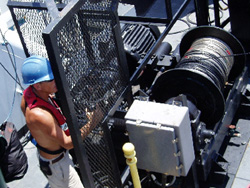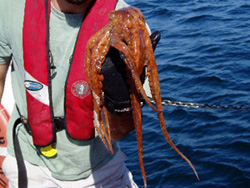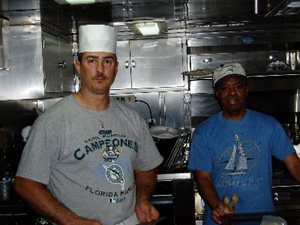|
 |
|
Daily
At-Sea Logs |
|
It is our fifth day aboard the Nancy Foster and the work schedule is running like clockwork, thanks to our Chief Captain, Greg. He has done an outstanding job of developing and ticking to a schedule that works for both the science team, as well as the ship’s crew. Today’s
agenda involves mostly the deployment of the video logger and fish
traps. To deploy these instruments, the scientists must rely heavily
upon the ship’s crew. Therefore, it is important that the scientists
develop a good working relationship with the crew It
is now 1000 hours (10:00 AM) and we have already deployed and retrieved
the video logger, as well as one fish trap. It may be several hours
or days before we review the footage captured by the four cameras
on the video logger. However, the fish traps are a different matter.
Once the trap is pulled to the deck, most everyone gathers immediately
to catch a glimpse of the animals living in the ocean. The catch was
not surprising because it was similar to traps that were previously
Once the fish in the trap are counted, weighed, and their lengths are measured, Athan and Marion clean the aft deck and their equipment in order to prepare for the next deployment. It is very important that everything is ready to go for the next round so no time is lost. The cost of running a vessel like this one is nearly $4000 per day, so we want to make sure that we use our time on board as efficiently as possible. We pulled in another chevron fish trap at 1045 (10:45 AM) hours. The catch appeared to be more of the same, including another octopus. These animals must really like the hard bottom habitat beneath us, as many other fish do. The differences in fish abundance and diversity in the hard bottom area as compared to the sandy bottom are quite remarkable. The relief of the hard bottom provides a variety of habitats for many of the fish and other animals in ocean. Additionally, many of the animals prefer this environment because they are more protected in a hard bottom area than in the sandy bottom areas. It is 1230 hours and we have just finished eating lunch in the galley (dining hall). One of the best things about being on this boat is not only the great research, but also the food. For lunch today, Jesse the Chief Steward and Dennis the Second Cook, prepared a Cajun dish with alligator meat. This was my first time trying alligator and believe it or not, it was excellent. These guys really know how to take good care of the visitors to the ship, as well as the other crewmembers here on the Nancy Foster.
Cheif Steward Jesse (on left) and Second Cook Dennis (on right)
As I reflect on my experience so far with this group of scientists and crew, I am beginning to realize the complexity of marine ecosystems. We have been blessed with another wonderful day of research in Gray’s Reef. Please check back tomorrow to continue following our adventures in the sanctuary. Signing
off, |
|||||||||


 because
they are an integral part of the research. For example, the deployment
of the video logger requires at least three individuals to guide it
to water. Two scientists are needed to direct the instrument overboard,
as well as at least one person from the ship’s crew. Usually
Jeff, Chief Boatswain (the person who runs the deck operations), is
present to operate the winch (picture
on right) that lifts the unit off the deck and into the ocean.
because
they are an integral part of the research. For example, the deployment
of the video logger requires at least three individuals to guide it
to water. Two scientists are needed to direct the instrument overboard,
as well as at least one person from the ship’s crew. Usually
Jeff, Chief Boatswain (the person who runs the deck operations), is
present to operate the winch (picture
on right) that lifts the unit off the deck and into the ocean. recovered.
The majority of the fish were black seabass and tomtate. To my delight,
we caught two more shark suckers, and believe it or not, an octopus!
(picture on left) As Athan tried
to pick up this slimy creature, the octopus slithered right out of
his hands onto the deck. The harder Athan tried to remove its tentacles,
the more it would stick to the deck with his suction cups. Finally,
the octopus gave up his hold on the ship and Athan tossed it overboard.
recovered.
The majority of the fish were black seabass and tomtate. To my delight,
we caught two more shark suckers, and believe it or not, an octopus!
(picture on left) As Athan tried
to pick up this slimy creature, the octopus slithered right out of
his hands onto the deck. The harder Athan tried to remove its tentacles,
the more it would stick to the deck with his suction cups. Finally,
the octopus gave up his hold on the ship and Athan tossed it overboard.
 Greg
and Dave just loaded into the MonArk, a small motor boat (picture
on left),
with Lou who serves as the Field Operations Officer, and Mike, the
Ordinary Seaman, to ensure that divers away from the ship before they
dive to the ocean floor. Using the same methods that were used on
the last transect dive, Greg and Dave will swim along two transects
and collect data on the fish that they observe. The water here in
Gray’s Reef is much different from the coastal waters that many
are familiar with; it is clear and a vibrant blue color. This is very
different than the seawater that I am used to in Charleston, S.C.
The coastal water near Charleston is cloudy with a brownish- grey
hue, due to the tremendous amount of sediment from the mainland being
deposited into the ocean by the adjacent rivers.
Greg
and Dave just loaded into the MonArk, a small motor boat (picture
on left),
with Lou who serves as the Field Operations Officer, and Mike, the
Ordinary Seaman, to ensure that divers away from the ship before they
dive to the ocean floor. Using the same methods that were used on
the last transect dive, Greg and Dave will swim along two transects
and collect data on the fish that they observe. The water here in
Gray’s Reef is much different from the coastal waters that many
are familiar with; it is clear and a vibrant blue color. This is very
different than the seawater that I am used to in Charleston, S.C.
The coastal water near Charleston is cloudy with a brownish- grey
hue, due to the tremendous amount of sediment from the mainland being
deposited into the ocean by the adjacent rivers.